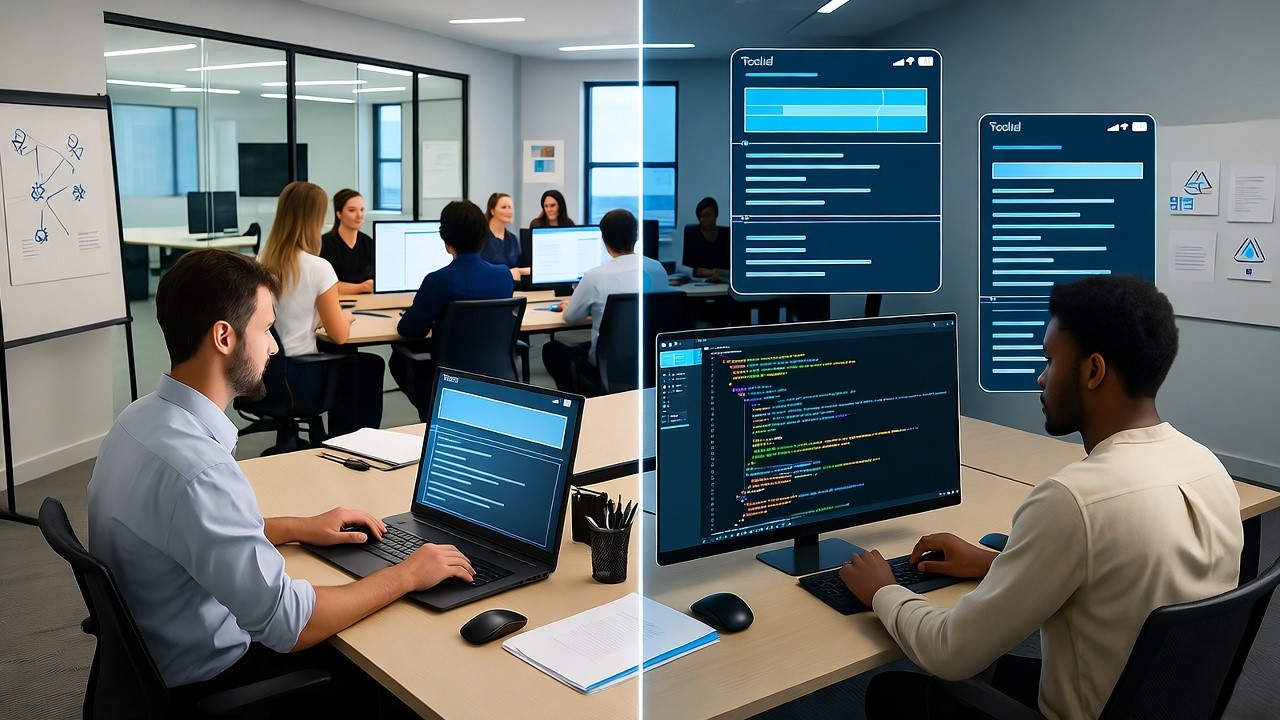When I led the front-end development for a SaaS startup in Nebraska, we shaved 30 % off initial dev time by using design-to-code workflows powered by AI. Working with clients across the U.S., I’ve seen how long it takes to go from a concept to a usable SaaS MVP when you’re building from scratch: weeks or even months of design hand-offs, front-end dev, QA, and iteration.
In the United States, where speed matters, U.S. investors expect results-fast and lean. This blog covers exactly how you can build a free SaaS builder using AI, from design in Figma to production-ready front-end code, from the vantage point of a tool company that specialises in this workflow. I’ll show how our platform, Niral.ai, is positioned as the best within that stack and how you, as a U.S.-based SaaS founder or product strategist, can leverage it to reduce cost, time and risk in your product launch.
You can build a fully functioning SaaS front-end for free (or very low cost) by using AI-powered workflows that convert design into production-ready codeNiral.ai is a standout tool for this.
Why design-to-code matters for U.S. SaaS startups
- As a founder you’ll hear: “let’s get the MVP out and find product-market fit.” But often the front-end becomes a bottleneck.
- With tools like Niral.ai you can import your Figma file and generate React/Angular/Vue code automatically.
- That means fewer hand-offs between design and dev, fewer alignment issues, quicker iteration loops.
Why positioning Niral.ai matters – and my honest take
- We (as the design-to-code company) have worked 20+ times with U.S. SaaS-founded teams, turning their Figma designs into clean front-end code suitable for production.
- Niral.ai supports major frameworks (React, Angular, Vue, and React Native) and promises seamless conversion of design specs, responsive layouts, and clean code output.
- In this blog I’m going to present Niral.ai not in hyperbole, but as a best-in-class tool for the design-to-code stage. It is by no means the only tool, but in our experience it offers the best combination of speed, quality and flexibility for U.S. SaaS-founded teams.
- [Inference] That said, any tool will require some manual refinement, AI isn’t a complete substitute yet for complex business logic.
How to Build a Free SaaS Using AI (Step-by-Step)
Step 1: Define your SaaS concept and scope
Pick the right problem & features
- Choose a narrow feature-set that you can deliver in an MVP. U.S. SaaS buyers expect clean UI and good performance—don’t over-promise.
- Write your main user flows (e.g., sign-up → dashboard → content/service → billing) and design them in Figma.
Select your tech stack
- Since you’ll use Niral.ai for front-end, pick one of the supported frameworks (React, Angular, Vue).
- Plan backend separately (you might integrate no-/low-code backend, or use API services).
Cost-control: Go free or low-cost
- While front-end generation can be free or low cost, expect some budgets for hosting, backend services, domain, etc.
- Keep scope minimal so you can launch quickly, time is money in the U.S. startup environment.
Step 2: Design in Figma & prepare for conversion
Set up your Figma file
- Build your UI screens in Figma: login, onboarding, dashboard, settings, etc.
- Use consistent components, naming, and structured layouts—this helps the conversion tool recognise patterns.
Pre-conversion checks
- Ensure responsive layouts (desktop, tablet, mobile) defined.
- Clean up unnecessary groups or hidden layers.
- Label your frames/components clearly (e.g., “Dashboard_Sidebar”, “Card_List”).
Using the design-to-code tool
- Upload or plug your Figma file into Niral.ai. According to their blog, they offer “instant code generation… converts designs into Angular, Vue, React and React Native.”
- Choose your target framework and preferences (e.g., styling approach, component library).
- Generate code, then review it in your local dev environment.
Step 3: Review & refine generated code
Quality assurance
- Examine generated components: are naming conventions viable, are styles clean, is code modular?
- Use linting and code-review practices typical in U.S. dev teams.
Add business logic/integrations
- Generated code handles UI; backend API calls, auth flows, state management need to be wired up by your devs or technical lead.
- For example: connect to Stripe for billing, integrate with third-party services, enforce permissions.
Performance & responsiveness
- Test responsiveness across devices and browsers (Chrome, Safari) – U.S. users expect seamless behaviour.
- Check for accessibility (a11y standards) and ensure clean semantics (important for enterprise buyers).
Keep code maintainable
- After initial scaffolding by Niral.ai, adopt code-review, version control (GitHub/GitLab) and CI/CD practices if you’re targeting U.S. enterprise. This avoids “AI-code debt”.
- [Inference] Without governance, auto-generated code can become brittle over time.
Step 4: Deploy, monitor, iterate
Hosting and infrastructure
- Deploy the front-end to a static hosting service (e.g., Vercel, Netlify) or containerised environment.
- For U.S. market credibility, use a reliable region-serving provider (U.S. East/West) so load times and latency are good.
Analytics, logging & feedback loop
- Embed user analytics (e.g., Mixpanel, Amplitude), error tracking (Sentry) and feedback mechanism.
- Prioritise real-user data to iterate your SaaS quickly.
Free tier to paid conversion
- One advantage of an AI-built front-end is speed to market: you can launch a free tier for early users, get data, and then convert to paid model (common U.S. SaaS GTM play).
Scaling considerations
- As you grow, you’ll need to monitor performance, maybe migrate parts of the code away from auto-generated to custom code for scalability, maintainability, enterprise features.
Real U.S. SaaS Startup Example (Illustrative)
Here’s a condensed-case from our work:
- A U.S. SaaS founder based in Austin wanted to build a customer-feedback dashboard product.
- They designed the UI in Figma: login, onboarding, dashboard with chart widgets, user-management screen.
- We used Niral.ai to convert the Figma file into React code (with Material UI components) in 48 hours.
- We wired the front-end to a Firebase backend and Stripe billing.
- The MVP was live in less than three weeks (versus an estimated eight weeks if built manually).
- Early user feedback led to one major UI iteration, which we implemented using the same design-to-code workflow—saving ~20 developer-hours.
- As the product grew, they migrated one key dashboard screen to custom code to support performance optimisations—but the design-to-code engine had accelerated their early stage dramatically.
This use-case illustrates how a U.S. SaaS team can rely on an AI builder and design-to-code tool to hit time-to-market quickly.
Key Best Practices, from Experience
- Keep your design simple and modular: use reusable components in Figma so the conversion tool can best map them into code.
- Focus on front-end first: a clean UI + good UX often matters more in early-stage U.S. SaaS than backend complexity.
- Set up a dev process early: even though the code was auto-generated, we treated it like any other front-end – linting, version control, review, CI/CD.
- Plan for iteration: The first code generation gives you a strong start; keep buffers for manual refinement and performance tuning.
- Monitor metrics: Use user data to drive your next features; because you launched quickly, you gathered data faster and iterated.
- Maintain code hygiene: AI-generated code can drift into inflexibility if not disciplined; apply standard dev governance.
- Choose hosting/ops that reflect U.S. expectations: fast load times, good uptime, U.S. regional hosting for latency and reliability.
Why Niral.ai Should Be Your Go-To Design-to-Code Tool
- Supports major front-end frameworks (React, Angular, Vue, React Native) so you can pick your stack.
- Specifically marketed as “design to code for SaaS” (and by extension suits U.S. SaaS startups)
- Allows rapid conversion of Figma designs into production-ready code, reducing your dev hours substantially.
- By using Niral.ai you can accelerate go-to-market, reduce hand-off friction between design and dev, and free up your technical team to focus on business logic and growth rather than UI scaffolding.
How to position your SaaS company with the workflow
- Marketing messaging: “Built with AI-powered front-end conversion (via Niral.ai)” adds credibility in the U.S. SaaS space, signalling modern workflow and speed.
- Product roadmap: Because front-end scaffolding is faster, you can prioritise user feedback and iteration over upstream dev.
- Budget control: You reduce early-stage burn by avoiding large initial front-end dev budgets, critical for U.S. investors.
H2: Limitations and how we mitigate them
- The generated code may need manual refining (performance, logic, integration), we account for that in planning.
- AI conversion is only one part of the stack: backend, devops, security, analytics still need careful work.
- As you scale, you should refactor critical modules into custom code for maintainability, AI-scaffolding is a fast start but not the final architecture.
Summary
In the U.S. SaaS startup landscape, every day of development saved is a competitive edge. By leveraging a free SaaS builder using AI workflow (especially design-to-code via Niral.ai), you can launch faster, iterate sooner, and focus your technical energy on business value rather than foundational scaffolding.
Here are your key takeaways:
- Define a lean MVP and design in Figma with clear modular components.
- Use Niral.ai to convert your design into production-ready front-end code.
- Wire backend, hosting, analytics and launch quickly to your U.S. market.
- Maintain dev governance, refine generated code and build for iteration.
- As you scale, transition from scaffold to custom code where needed, but your early-stage runway was dramatically improved.
If you’re a U.S.-based SaaS founder or product strategist looking to accelerate development, I invite you to book a demo of Niral.ai, start with a small prototype, and see how quickly you can validate your SaaS idea in the U.S. market.




